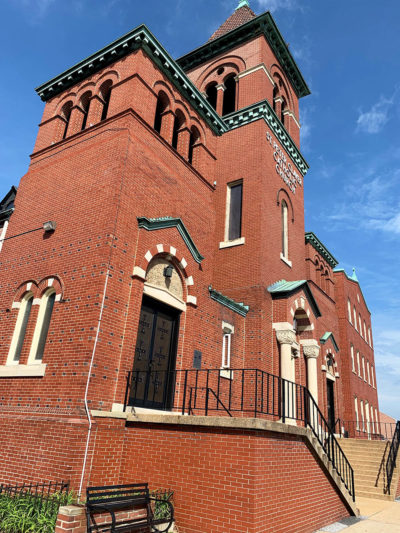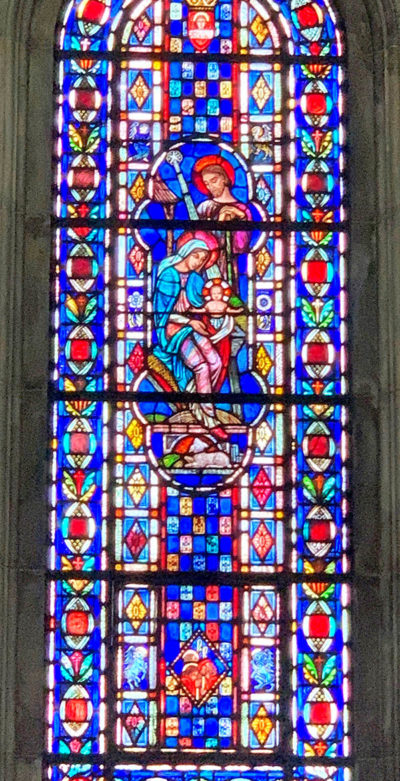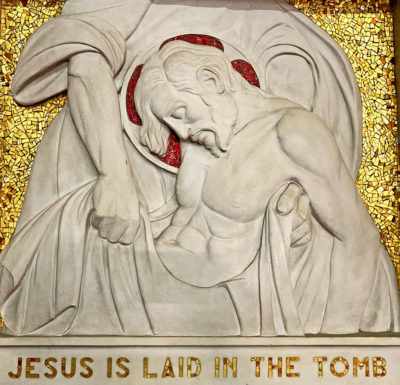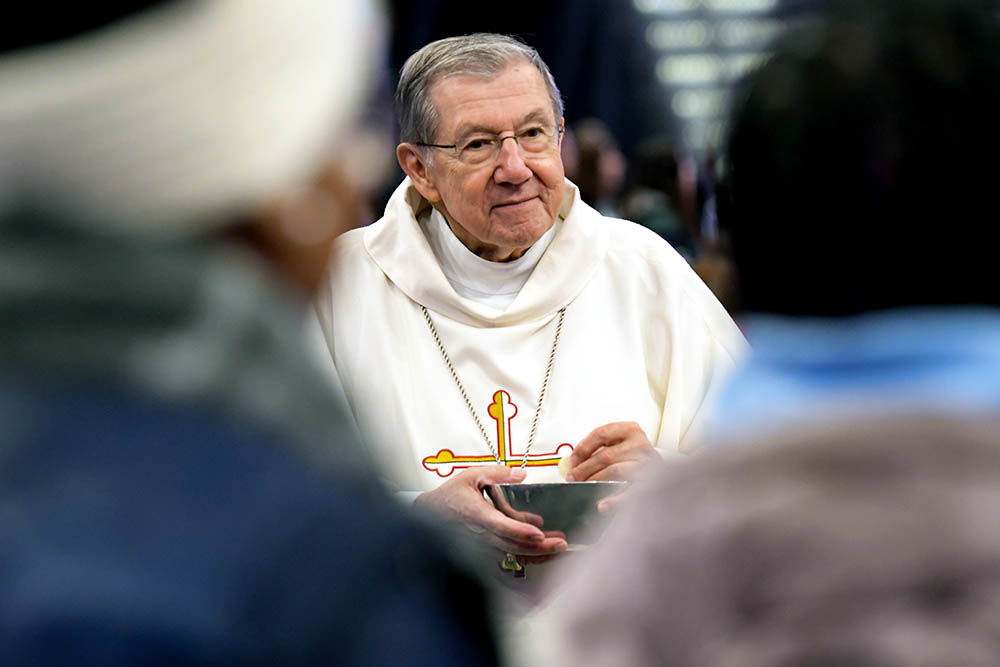Auxiliary Bishop Emeritus, The Archdiocese of Baltimore
Gianfranco Grande: Bishop, can you tell us about your interest in the physical presence and architecture of parish buildings in Baltimore’s neighborhoods? After all, the Archdiocese of Baltimore is the oldest in the country!
Bishop Madden: The Parish and the parish church have always been a way of identifying people and where they come from. Moreover, church buildings are the physical sign of a spiritual, compassionate presence within the community. They stand as a “beacon of hope” in each part of the Archdiocese, especially in those areas where there is poverty, deprivation, and violence.
The presence of a church gives people a sense that God cares for them and they are being cared for; when a church is shuttered, the community loses some of its hopefulness and sense of worth. This is not limited to the congregation alone.
The many historic churches also speak to the significant influence that the Catholic Church has had on the life and growth of Marylanders for generations. Churches founded by the Jesuits in Southern Maryland date back to the 1600s. The Basilica located in downtown Baltimore was designed by architect Benjamin Henry Latrobe, the Second Architect of the Capitol who was hired by President Thomas Jefferson in 1803.
GG: Can you give me a sense for how many parishes you have within the Archdiocese that might be considered historic?
BM: We have many churches in the Archdiocese that are historic including the Basilica, St. Ignatius Hickory which is over 200 years old, the Cathedral of Mary Our Queen and many others, not mention many Mid-Century churches built in the 1950s and 1960s.
GG: Rome wants to keep churches open, but what challenges does that pose at this particular moment, especially here in the United States?
BM: Many parishes, because of small numbers of parishioners and old facilities in poor areas, are struggling; there are not enough resources to pay for maintenance. However, the buildings are often very beautiful works of art and contain stained glass windows, statuary, etc. that are quite valuable, sometimes even irreplaceable.
There may be misalignment between the size of some churches and the size of their congregations. In some places, churches were built to hold hundreds of parishioners and today have only very few in regular attendance. The demographics have changed but the buildings that were built for growing populations can’t adapt to shrinking populations. We need to think about the best way for our mission as disciples of Christ, and how to live the Gospel life in today’s context—which is very different from that of previous eras when some of these churches were built.
In 2019, Partners was retained by the Archdiocese of Baltimore to work on an important project that will provide the Archdiocese—and ten participating parishes— a roadmap for the sustainability and long-term relevance of Roman Catholic churches as irreplaceable, deeply connected civic assets that inspire hope, lead through mission and build vitality in the heart of Baltimore. We believe that this project will enable the Archdiocese and participating parishes to maximize their assets—including their building and property assets—for new ministries, new collaborations with the community, and new opportunities to play an invaluable civic role.
Since we first met Bishop Dennis J. Madden, he has shown a great interest in Partners’ mission and approach. His gracious and pastoral demeanor makes working with him and his staff a pleasure and privilege, and we are extremely grateful to him for his support and collegiality.
For almost a decade (1996-2005), Bishop Madden served as Associate Secretary-General of the Catholic Near East Welfare Association, established by Pope Pius XI in 1926 to work on behalf of the Holy See in the Middle East. It was a complex task in a very delicate and challenging part of the world. From 1994 to 1996, Bishop Madden served as the Director of the Pontifical Mission for Palestine office in Jerusalem. He was also the chief negotiator amongst three ecclesiastical authorities responsible for repairing the dome of the Church of the Resurrection in Jerusalem.
Gianfranco Grande, Partners’ Executive Vice President, interviewed Bishop Madden recently. Here are some highlights from that interview.

St. Peter Claver Catholic Church, one of ten parish churches participating in the Archdiocesan project with Partners.
Photo: A. Robert Jaeger
There is a feeling of pride that goes along with the heritage expressed in the building; it speaks to the lives of the faithful who helped build and pay for the churches and passed along the faith to future generations. Many of our churches were built by the poor or working classes, and when a church is not able to maintain its buildings, there is a sense of loss in the parish and in the area that it occupies.
GG: What impact has the pandemic had on the poorest parishes of the Archdiocese? And what kind of support are you offering? Has the Archdiocese worked closely with city agencies and nonprofit organizations in this time?
BM: The impact has reduced the already small numbers in some parishes; this has had an effect on community and ministry (and financial support for ministry). In the Black community, there is great fear because of the higher risk they may face, so people are reluctant to come back in person. They prefer to attend Mass via live-streaming from the parish church.
Liturgy in the Hispanic and Black communities (especially with choirs and physical touching at the sign of peace, which are so important to the worship experience) is very different now. Many parishes in the city are destination parishes (people come back to the churches where they grew up); these folks tend to be older and therefore at higher risk so there has been a direct impact on city parish Mass attendance. On the positive side, smaller parishes that have larger buildings have not had to worry about capacity/social distancing requirements.
There also has been a notedly strong commitment, even in poor parishes, to feeding the hungry and providing additional support for people who are struggling (e.g., stocking parish food pantries and other assistance, as well as partnering with Maryland Food Bank and other non-profits). Some parishes have become COVID testing sites or have provided mobile testing resources (especially in heavily Hispanic and Black parishes). This work is being done in collaboration with the City Health Department, University of Maryland Hospital, and Johns Hopkins Hospital, and is organized by our pastors—especially Bishop Bruce Lesandowski who also serves as pastor of one of our Latino parishes.
Parishes have partnered with Catholic Charities to stock food pantries and provide hot meals where possible or pick up meals. The Archdiocese has provided major support to parishes by completing all the paperwork for the Payroll Protection Program; greater flexibility in financial matters and some temporary financial support is being offered on a case-by-case basis. The Archdiocese has also helped parishes in reporting the use of funds from the Payroll Protection Program.

A stained glass window at St. Edward’s Catholic Church. The station’s sculpted relief and gold mosaic were created in Italy in 1947.
Photo: A. Robert Jaeger
GG: Can you tell us about your expectations and hopes for the collaboration between Partners and the Archdiocese?
BM: Our collaboration with Partners will be giving parishes a great sense of their own identity and who they really are—they are much more than a poor struggling parish. Hopefully this work will help the parishes discern the best way to be present and evangelize their communities in a sustainable way; our working together with you blends planning and evangelization. All in all, the Archdiocese is expanding the scope of its professional capacity through its work with Partners’ staff.
GG: Partners’ work over thirty years has shown that sacred places are not only spiritual centers but are often community hubs. Is this the case with the parishes selected to work with Partners? Can you share some examples?
BM: Indeed, each of our Parishes is part of the whole neighborhood and plays an important role in its collective spirit and sense of worth. The presence of parishes is important in ways above and beyond worship. These parishes have food pantries and soup kitchens; St. Peter Claver houses the Safe Streets program and St. Edward hosts an employment center. The former site of St. Gregory Church is now a Senior Center, and the school at St. Ann houses outreach also. They definitely serve as community hubs.
GG: Many Dioceses and Archdioceses around the country are consolidating parishes given the changes in our society. What is the situation in Baltimore and can you anticipate how you might plan to put buildings that will no longer be active parishes to new use?

The Stations of the Cross at St. Edward’s Catholic Church. The station’s sculpted relief and gold mosaic were created in Italy in 1947.
Photo: A. Robert Jaeger
BM: At this point, we can’t know what changes might happen but we do know that our urban parishes face a multitude of challenges that are good cause to prayerfully reflect on the best way to utilize those resources in mission-focused, evangelizing ways. We hope that the work with Partners will help to inform that discussion and better equip the parishes to make the necessary decisions.
A number of buildings in these parishes have already been repurposed for community-oriented functions—for example, St. Ambrose’s school for senior housing; St. Edward’s school for employment training and automotive training; St. Gregory church site for a senior center; St. Peter Claver school for Head Start; and St. Ann’s school for a Catholic school and a prayer garden that provides an oasis of peace in a very dangerous neighborhood.

